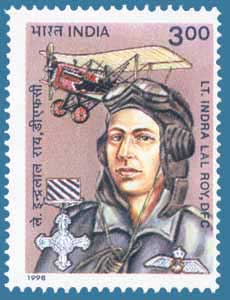
Lt. Indra Lal Roy DFC

Lt. Indra Lal Roy (1898 - 1918) was the one Indian pilot who distinguished himself most in the First World War.
Indra was born in Calcutta on 2nd December, 1898. His father Shri P. L. Roy was a wealthy Barrister and Zamindar from Barisal, now in Bangladesh. Indra was academically brilliant and won several scholarships and joined Oxford University, in England . Even as a student he evinced great interest in aviation and used to spend much of his time making models of aeroplanes.
At the age of 18 years he joined the Royal Flying Corps and obtained the King's commission on July 5, 1917. Within a few months he was appointed Scout Airman and was posted to 56 Squadron of RAF in France for military operations against Germany. According to a contemporary report in the Times of London, Lt. Roy did fine work at the war front till December 1917 when his plane was shot down by the Germans in the battle of Cambray. He lay unconscious for three days, till he was picked up by the British troops and carried to Etaples British Military Hospital in France. There he was declared dead and sent to the mortuary. However, he regained consciousness and recovered.
He refused to admit defeat and worked his way back to flying duties. He was subsequently promoted to the rank of Lieutenant and joined duty in July 1918 to 40 Squadron in France. Here he proved his mettle as a war pilot and accomplished the extraordinary feat of shooting down ten German aeroplanes within a short period of fourteen days in July, 1918. But his brilliant career was cut short abruptly when he was killed in a "dog" fight with a German war plane over Estevelles, Pas de Calais, France on 22nd July, 1918. His SE5A (B180) aircraft went down in Flames at 0850 hours on the fateful day. He lies buried in the cemetery of Estevelles.
For his dare devil courage and exemplary performance he was posthumously awarded the coveted 'Distinguished Flying Cross1, which was recorded in the British Gazette of September 21,1919, the first Indian to receive this distinction of honour and gallantry. The citation said " A very gallant and determined officer, who in 14 days accounted for 10 enemy machines. In these several engagements he had displayed remarkable skill and daring, on more than one occasion accounting for two machines in one patrol"
Date of Issue: 19.12.1998
Back